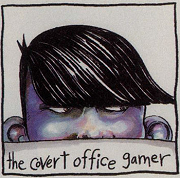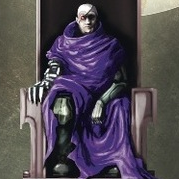|
quote:There are some good reference pages on BGG. The bulk of Mage Knight is "read this thing" and once you know the steps the take you can reference the game easily with a good printout. You know how to move and attack, that's the bulk of the game. Oh no, I forgot how to interact with a monastery. Well, the crib sheet tells me exactly what to do. Continue on. Sure, if you consult the rules and reference cards often, you will get most of the rules right (although I discovered a couple things we had always done wrong while reading the Frontiers manual and checking backwards), but that's a pretty low bar. I think there's a misconception in general, and which Mage Knight exemplifies, that having more variance between choices creates deeper strategy or something. You see this a lot with, like, people's "Chess 2.0" type games. They make pieces that have more complicated movement rules, asymmetrical sides, and different rules for movement vs. capture and whatever. In general, this creates a game that can be more difficult to play competently (and thus rewards skill heavily as players move from beginners to novices) but is actually less conducive to strategic play at every other level. To support strategic play, games need clarity. In Chess, this means that players are quickly able to get to the level where they can assess the board. They don't have to think about each piece to see which spaces of the board are safe and which can be attacked next turn by what. While a player is at the level where they have to check each piece, each turn, to remember where it can move, they are just barely playing Chess. They're able to follow the rules and generally progress towards an end, but they're not playing well enough to appreciate why the game is good. With Mage Knight we have two possible interpretations: 1. All the variances between different hex types are important, and should meaningfully inform your decision making about where to go and what to do (ie. I'd go there if it was daytime, but won't since it's night and therefore X). In this case, the lack of clarity in these rules (something proven by the fact that even experienced players have to consult cards and rules) robs the game of meaningful strategy (just as Chess is much less strategic until you intuitively know which pieces can attack what without looking up the rules for each piece). To be clear, it's not just about MK rules here, it's about the variety of monsters one might expect. To play well, really you should know things like "how many of the monsters that can spawn here are fortified?". Having that knowledge for Mage Knight is going to take a lot of play, and until you have it, these differences effectively just make your decisions more random. 2. Many of the variances are not important and don't need to be considered when making decisions about where to go and what to do. In this case, you have a bunch of extra rules for nothing. In practice, I find it's mostly #2. When I flip over a tile in Mage Knight, it is very normal that I just go interact with whatever popped up there regardless of what it is (obviously this isn't an absolute - but in practice I find it happens a lot). Movement costs too much, and the game is tight enough on time, that you need to make steady progress and get something out of whatever you run into. So largely I'm effectively getting random encounters, and the fact that when I consult the card I find out that I can't see the monster there because it's night now just makes my decisions 1 step less meaningful.
|
|
|
|

|
| # ? May 16, 2024 19:02 |
|
jmzero posted:Sure, if you consult the rules and reference cards often, you will get most of the rules right (although I discovered a couple things we had always done wrong while reading the Frontiers manual and checking backwards), but that's a pretty low bar. On a very high level I see where you're coming from but the variance in the locations forces a lot of tactical decisions. Fortified or not is a huge deal depending on how you've been building your deck, and rampaging orcs are a roadblock best avoided rather than fought. Dungeons reward ranged combat but require more risk assessment after you add in Lost Legion. The rewards for the various spaces are important as well. Artifacts are great but is the reputation loss worth burning the monastery right now or is what is present in the unit offer more tempting? Or should I go for the Mage Tower even though the number of spells I have is already going to be tough for my mana base to handle? Does my hand mean I can steamroll the valuable location or did I get a bad draw and should try to take something less valuable until I draw what I need? Is this tile effectively garbage and should I explore somewhere else? Without the variance you're not asking most, if any, of those questions. I'd like to refer you to the solo game where I drew no mage towers as an example of how much of an impact the various locations' rules have on the game.
|
|
|
|
There are little cards handy so if you walk up to a thing you don't remember you just check the card. It was my wife's second game after D&d ravenloft boardgame and she did fine. The provoking rules are really simple and there are a couple governing principles you can apply to any situation. I think people over think things. But hey, if it doesn't click it doesn't click. I can't remember poo poo about car maintenance no matter how many times I'm told and my dad has to re-explain crib everytime we play  Edit: just to add my 2 cents, those rule cards aren't needed that often and it's normally to be sure of a little rules thing- it is usually fairly intuitive. Harvey Mantaco fucked around with this message at 19:29 on Sep 19, 2016 |
|
|
|
Fire and ice block are still the worst offenders for me. Ice attacks inflict ice damage, ice resistance resists ice damage, so logically, ice block blocks... fire damage? I can see why it is what it is, but it's not consistent in the way it's worded. If ice block blocked ice, that would be much easier to remember.
|
|
|
|
Holy smokes, the FFG/GW split is really creating some interesting scrambles. 401 Games was advertising CitOW for $99 CDN with a note about a limit of 2 per customer. Wild, considering I paid $40 for it a year ago.
|
|
|
|
FulsomFrank posted:Holy smokes, the FFG/GW split is really creating some interesting scrambles. 401 Games was advertising CitOW for $99 CDN with a note about a limit of 2 per customer. Wild, considering I paid $40 for it a year ago. I saw that too. It looks like they sold 30 copies in the last few days.
|
|
|
|
Dirk the Average posted:Fire and ice block are still the worst offenders for me. Mage Knights don't have any resistances. Seems consistent to me.
|
|
|
|
FulsomFrank posted:Holy smokes, the FFG/GW split is really creating some interesting scrambles. 401 Games was advertising CitOW for $99 CDN with a note about a limit of 2 per customer. Wild, considering I paid $40 for it a year ago. You know, I bought Fury of Dracula at full retail because I had been interested in it anyway, but I held off from buying Forbidden Stars, because a hundred dollar game is going to push my "still shrinkwrapped board game backlog" value over my already ample Steam backlog value. Actually if I include X-Wing Miniatures that have never hit the table, I've probably got another couple hundred bucks there too
|
|
|
|
Speaking of hard to parse rules, Robinson Crusoe is getting a new edition and an edited rulebook. I know many people in the thread don't think so highly of this game, but the accompanying article about the importance of editors is pretty great. Some highlights from that article:What Does An Editor Do? posted:Paul Grogan: I found your official answer at BGG about moving camp. What Does An Editor Do? posted:Paul Grogan: The Ballista (in scenario 5)
|
|
|
|
canyoneer posted:You know, I bought Fury of Dracula at full retail because I had been interested in it anyway, but I held off from buying Forbidden Stars, because a hundred dollar game is going to push my "still shrinkwrapped board game backlog" value over my already ample Steam backlog value. I took the plunge on Forbidden Stars because it seems up my alley and apparently plays well with 2, which is a big plus in my books. My buddy has Fury and we played it once and it went for three and a half hours and my GF was Dracula and she did not have a good time waiting ten minutes or so between her actions. I'd try it again but I didn't like it nearly enough to care about buying it just because it's going away.
|
|
|
|
cenotaph posted:On a very high level I see where you're coming from but the variance in the locations forces a lot of tactical decisions. Fortified or not is a huge deal depending on how you've been building your deck, and rampaging orcs are a roadblock best avoided rather than fought. Dungeons reward ranged combat but require more risk assessment after you add in Lost Legion. The rewards for the various spaces are important as well. Artifacts are great but is the reputation loss worth burning the monastery right now or is what is present in the unit offer more tempting? Or should I go for the Mage Tower even though the number of spells I have is already going to be tough for my mana base to handle? Does my hand mean I can steamroll the valuable location or did I get a bad draw and should try to take something less valuable until I draw what I need? Is this tile effectively garbage and should I explore somewhere else? Without the variance you're not asking most, if any, of those questions. I'd like to refer you to the solo game where I drew no mage towers as an example of how much of an impact the various locations' rules have on the game. Well yeah, there needs to be different locations for the game to work. But the differences between locations should be meaningful, intuitive and clear. Some of them are. What you can do in a Mage Tower (buy a spell or hire a wizard) is appropriately different than what you do in a Keep (get more resources, hire a Knight). But other parts of the variation are lame. Like OK, sure, ranged combat is good in dungeons. But that's not in any way intuitive thematically, is not clear when surveying the board (until you've played a lot of games), and even when you have a good idea what being a "dungeon" means, you're still often not going to have an effective decision related to that knowledge. Depending on what else is around and whether other players are in range of taking it first, quite often you're just going to have to do it, even if it doesn't fit exactly what you want to do right now. To be clear, I'm not imagining a board where all the spaces are the same, I'm imagining a board where there's fewer different base types of spaces (and probably fewer different monster piles), where those spaces at their base work more consistently, and the board uses iconography to get the rest of the way there on variation. It doesn't take many icons to say "this spot spawns 2 'magic level 2' enemies, and the player who defeats them gets a spell". Barring "hidden" or "fortified" or "angry" icons or whatever, enemies are visible as soon as they spawn, and you fight them by moving onto their space. Now even new players can quickly survey their options, risks, and rewards on the board (and knowing what happens means they can make meaningful decisions about what to try), and you haven't necessarily lost any design space (you may actually have more, since you can make spaces that work in different combinations of ways). And, again, I'm happy with lots of the game. Choosing cards and skills that work together, balancing your deck in different ways to be able to get things done - all that stuff seems great, and that's why I push through the messy fiddly bits. VVV: Remembering Robinson Cruesoe does put this in perspective though. Mage Knight is a great game I'm nitpicking. There's a lot of terrible games out there. jmzero fucked around with this message at 20:57 on Sep 19, 2016 |
|
|
|
Oh hey it's time yet again for SU&SD to slob some Dead of Winter knob.
|
|
|
|
golden bubble posted:Speaking of hard to parse rules, Robinson Crusoe is getting a new edition and an edited rulebook. I know many people in the thread don't think so highly of this game, but the accompanying article about the importance of editors is pretty great. Some highlights from that article: After reading Ignacy's posts on BGG about playtesting with Vlaada I find myself pre-judging as bad everything Ignacy works on. It doesn't help that Imperial Settlers is incredibly unbalanced and 51st state is just bad. I played Robinson Crusoe once and hated it.
|
|
|
|
I know it was covered before, but just how likely is it that FFG won't print any more Letters from Whitechapel before March? My FLGS owner is fairly certain they will print more before the deadline, but his reasoning includes the assumption that as long as a box is bought and paid for by a store, GW can't recall it or sue FFG for selling without license. Is that true?
|
|
|
|
jmzero posted:Well yeah, there needs to be different locations for the game to work. But the differences between locations should be meaningful, intuitive and clear. Some of them are. What you can do in a Mage Tower (buy a spell or hire a wizard) is appropriately different than what you do in a Keep (get more resources, hire a Knight). But other parts of the variation are lame. Like OK, sure, ranged combat is good in dungeons. But that's not in any way intuitive thematically, is not clear when surveying the board (until you've played a lot of games), and even when you have a good idea what being a "dungeon" means, you're still often not going to have an effective decision related to that knowledge. Depending on what else is around and whether other players are in range of taking it first, quite often you're just going to have to do it, even if it doesn't fit exactly what you want to do right now. jmzero posted:To be clear, I'm not imagining a board where all the spaces are the same, I'm imagining a board where there's fewer different base types of spaces (and probably fewer different monster piles), where those spaces at their base work more consistently, and the board uses iconography to get the rest of the way there on variation. It doesn't take many icons to say "this spot spawns 2 'magic level 2' enemies, and the player who defeats them gets a spell". Barring "hidden" or "fortified" or "angry" icons or whatever, enemies are visible as soon as they spawn, and you fight them by moving onto their space. Now even new players can quickly survey their options, risks, and rewards on the board (and knowing what happens means they can make meaningful decisions about what to try), and you haven't necessarily lost any design space (you may actually have more, since you can make spaces that work in different combinations of ways). Then you're just replacing one type of fiddle with a different and frankly inferior one. In your example, enemies are face up and non-rampaging, except when they're not. Cutting down on the number of monster piles would require re-balancing in multiple areas of the game because of the expectations of what each pile does. Creating a more homogeneous mixture would either remove variety due to the necessity of all monsters in a pile being all around the same power level or, with a less skilled designer, introduce greater luck elements by having weak and strong monsters in the same pile. Drawing from a pile and adding modifiers makes it harder to balance as well. You now made it so you have to design around the possibility of having a rampaging crypt worm. The game already has this problem with cities, where in the white city a grey guard is hard to kill and worth a piddly amount of fame but in some of the other ones you can just sucker punch otherwise tough enemies for essentially free fame. That's one of the game's main weaknesses in competitive play and adding that to more spaces on the board is a bad idea. Having fewer piles with more modifiers also makes it more difficult to know what you're likely to fight since you're adding more permutations. It's just a bad idea from a design standpoint. It's tightly controlled the way it is now. I also don't understand why you think fewer types of spaces with more icons is going to be easier to understand. A new player will see the same kind of space but need to lean over the table to see how the enemy behaves and what the rewards are for every single space instead of seeing a mage tower and looking at the mage tower card. Your proposal makes it the opposite of intuitive and clear. I won't disagree that Mage Knight is fiddly but I think you're underestimating the importance of that fiddliness in regards to both information conveyance and game balance.
|
|
|
|
I enjoy Mage Knight, but I do feel like strategy is too often dictated by what the tiles (and shuffle) randomly present to you. The 6 round limit means that when you encounter a keep/mage tower/dungeon/etc., you must be able to defeat it immediately or lose the opportunity forever.
|
|
|
|
theroachman posted:I know it was covered before, but just how likely is it that FFG won't print any more Letters from Whitechapel before March? My FLGS owner is fairly certain they will print more before the deadline, but his reasoning includes the assumption that as long as a box is bought and paid for by a store, GW can't recall it or sue FFG for selling without license. Is that true? Do you mean Fury of Dracula? Letters From Whitechapel is unaffected. I don't expect there will be any reprints of any of the affected games. The deadlines are just too tight on a print run, even if they were able to stuff the channel like that they would probably have a hard time getting them through distributors in that time frame.
|
|
|
|
CaptainRightful posted:I enjoy Mage Knight, but I do feel like strategy is too often dictated by what the tiles (and shuffle) randomly present to you. The 6 round limit means that when you encounter a keep/mage tower/dungeon/etc., you must be able to defeat it immediately or lose the opportunity forever. If you play Mage Knight occasionally it can certainly seem that way, but the base scenario is designed with beginner play in mind. After a while you have to start cranking the difficulty for that six round limit to recapture it's initial sense of urgency. There are instances where you will wind up having to walk past stuff you'd rather take, but more often you'll have time to hang around until a card you need shows up.
|
|
|
|
Big McHuge posted:Oh hey it's time yet again for SU&SD to slob some Dead of Winter knob. That's not fair! That's because for some reason most major board gaming outlets slob all over Dead of Winter's knob.
|
|
|
|
I really think it's just gross the way SUSD describe games as 'sexy'. It's inappropriate and frankly meaningless. Except if you're talking about El Grande.
|
|
|
|
LuiCypher posted:That's not fair! That's because for some reason most major board gaming outlets slob all over Dead of Winter's knob. I really think that there would be a lot more criticism out there if SU&SD had taken the lead on treating it with a critical eye.
|
|
|
|
theroachman posted:I know it was covered before, but just how likely is it that FFG won't print any more Letters from Whitechapel before March? My FLGS owner is fairly certain they will print more before the deadline, but his reasoning includes the assumption that as long as a box is bought and paid for by a store, GW can't recall it or sue FFG for selling without license. Is that true? I'm not a lawyer but: He's probably thinking of the First-Sale doctrine. Basically, the copyright holder is afforded the exclusive right to sell the item to others, but once that sale is complete the buying party can do what they like with it and is not prevented from selling it again. So in this case, FFG sells a game to Monolithic Distributor, who sells it to Friendly Local Game Store who sells it to Joe Ameritrash. Once FFG has sold it to the distributor, it's theirs to do with what they like. GW can't tell them to stop. Problems with this: GW is not an American company, so I don't know if they could sue them in England where this may not apply. GW is litigious, so its not like they wouldn't try. Presumably FFG's lawyers are smart enough to only pull this in America, but then again, if that Imperial Assault / Hasbro story is true, maybe not. The reclaiming of copyright infringing goods from retailers is not unheardof. You may remember former video game developer Silicon Knights got sued by Epic Games for using copywritten code without licensing it. The result was that SK had to destroy all unsold copies of games containing the code. So GW could possibly claim that FFG is selling copyrighted IPs without an agreement. The thing I don't know is if they had retailers returning unsold retail copies or if it just applied to existing copies that they themselves had not yet sold. Still, if the First Sale doctrine works as it seems to, so long as FFG stops selling before the agreement is up, they should be in the clear. The last problem with this is the practicality of it. These types of printing do need some sort of lead time (I don't know how much, but it's not zero) and we hear about shipping problems from China happening a fair bit. Are you going to put capital down on a game to get it printed if there's a chance it will be stuck on a boat in California for 2 months due to a transit strike while the agreement slowly ticks down? They might, but they might not. So, yeah, I guess what I'm saying is I don't know.
|
|
|
|
Mags Knight is long and rules heavy, but the difference in it and Arkham Horror is that one is a good game and the other is a BS dice fest Cthulhu snoregasm. In other news, the League of Legends game looks kinda interesting. And they apparently have some insane production deals to sell that 16 pound box with (some) painted minis for $75.
|
|
|
|
theroachman posted:I know it was covered before, but just how likely is it that FFG won't print any more Letters from Whitechapel before March? My FLGS owner is fairly certain they will print more before the deadline, but his reasoning includes the assumption that as long as a box is bought and paid for by a store, GW can't recall it or sue FFG for selling without license. Is that true? Assuming you're actually talking about Letters and not Fury: a second run is all but guaranteed because the expansion is about to come out.
|
|
|
|
Bottom Liner posted:Mags Knight is long and rules heavy, but the difference in it and Arkham Horror is that one is a good game and the other is a BS dice fest Cthulhu snoregasm. Yeah, the four player minis are pre-painted and there's also 100 minion miniatures as well as a secret miniature (part of the legacy elements) that's larger than all of the others and was called "easily the most expensive piece". Seems ridiculously good value for the price, I have to wonder if Riot is even making a profit from this game. They might be selling at cost or even at a loss and marking it off as publicity. Here's an article that talks a bit about Quinns' consultancy. He was apparently the one to suggest adding a legacy campaign and modular boards, making them delay the release for over a year and a half to add those things.
|
|
|
|
The Secret Cabal got an early copy and did a video overview here. They call it a review, but it's a very shallow one. https://www.youtube.com/watch?v=4wi5ThCBLH8
|
|
|
|
Big McHuge posted:Oh hey it's time yet again for SU&SD to slob some Dead of Winter knob. Dead of Winter is fun though.
|
|
|
|
Malloreon posted:After reading Ignacy's posts on BGG about playtesting with Vlaada I find myself pre-judging as bad everything Ignacy works on. Ignacy is a poster boy for everything that's wrong with board games in TYOOL 2016: poo poo mechanics meant to "tell a story" that do the opposite in practice, defended by a poo poo designer that's too dumb/egocentric to take the sage advice given to him (like the nature of mathematics and the universe around him). I look forward to Robinson Crusoe being trashed and forgotten in the not-poo poo-games 2nd gaming renaissance with the only remaining copies being made out of discarded cereal boxes in rutibex's mom's basement
|
|
|
|
Bottom Liner posted:The Secret Cabal got an early copy and did a video overview here. They call it a review, but it's a very shallow one. Videos also dropped today from Watch It Played and The Dice Tower. At first I thought it might have been a huge media blast for everyone they could, but instead it seems they just actually know who's popular and/or good and who they wanted on board. Which is probably a good sign, or at least shows some awareness on their part. Game looks fine, like a minis version of Space Alert with a campaign mode. The $75 price point really shows what a billion-dollar company can do with the economics of scale on their side. e: Also, Radho. Magnetic North fucked around with this message at 00:47 on Sep 20, 2016 |
|
|
|
What is the thread opinion on Power Grid?
|
|
|
|
Dead of Winter is amazing, and no-one say anything bad about it. It's my baby.
|
|
|
|
GEMorris posted:What is the thread opinion on Power Grid? Still a classic, but you shouldn't play it with only two players. Is there any auction focused game that works with two players?
|
|
|
golden bubble posted:Still a classic, but you shouldn't play it with only two players. Is there any auction focused game that works with two players? Keyflower.
|
|
|
|
|
cenotaph posted:It only takes a couple of plays and a quick glance at the enemy guide to realize that if you have ranged attack 5 going into a dungeon is a great idea. Sure it might not be thematic but I found all of the locations and their implications very easy to quickly internalize. If you're arguing that a first time player should have their hand held to realize this then I fundamentally disagree with that school of design. The information is present, relatively clear, and it's up to you to process it. Showing the icons on the board is easier for a first time player without impeding an experienced player. I mean, Vlaada made this same decision, but the other way, for other parts of the game. Was he wrong in those cases? I mean, imagine an alternate game where each monster token was just a picture and had a definition on a card somewhere - like a Medusa token is just a picture, and so when you're fighting one you find the Medusa card and see it has Petrification and read what its stats are. Obviously that would be better because we don't want to hold a new players hand? And it would be better because instead of having to look at the symbols on the token you could just know what a Medusa does? And you wouldn't have to lean over the table to see those stats? I'm sure these situations are super different in your mind for some reason, but they look very similar to me, and I think having some icons is the right choice in both cases. quote:Then you're just replacing one type of fiddle with a different and frankly inferior one. In your example, enemies are face up and non-rampaging, except when they're not. Well, uh, yes? By default creatures would spawn face up and not be rampaging - just like, by default, creature tokens don't have haste or poison. Is that fiddly that they have poison, except when they don't? We could phrase all sorts of rules in nonsense ways to try to make them sound confusing. Alternatively, we could recognize that this pattern of default intuitive properties, with exceptions called out by icons or keywords, is normal across a variety of games that people like, and which people find easy to learn. In general, you seem to be treating my suggestions like they'd be houserules on top of the completed game of Mage Knight - like you'd have to explain to people that creatures don't attack you when you walk by them. Nobody would have thought that's what they do. Rather, they'd correctly assume they didn't - and then when you got to one with the marauding icon, you could explain what that means. (Or, honestly, you could get rid of the whole concept and not lose all that much, but I can't imagine you'd like that). Similarly, when you flip over a tile with monsters on it, you put the monsters the tile shows on that space face up. That is a really intuitive default that would confuse nobody. Nor do I think you'd create a bunch of confusion when you found a space with the hidden icon, where you don't get to see the monster until you move onto it (or, God forbid, until you move next to it in the night time - another whole branch of rules that aren't worth their weight). Anyway, to me, I think there's design decisions in MK that could have gone a different way and ended up with a game I like more. You seem to like/value different things, many of which I don't really understand, but overall I don't object to you liking things the way they are - I like Mage Knight too. jmzero fucked around with this message at 01:02 on Sep 20, 2016 |
|
|
|
Mage knight is like pancakes
|
|
|
|
Turtlicious posted:Dead of Winter is amazing, and no-one say anything bad about it. It's my baby. Your baby is cute but the people who made it have no idea what they're doing.
|
|
|
|
Man, Idk if that's true or not but it seems like with 20 pages of rules that are consistent and easy to learn, with some really cool character design, and awesome crossroads they got something right.
|
|
|
|
golden bubble posted:Still a classic, but you shouldn't play it with only two players. Is there any auction focused game that works with two players? That caveman game by the insane guy who makes rulebooks that look like time cube. Neanderthal I think?
|
|
|
|
Harvey Mantaco posted:That caveman game by the insane guy who makes rulebooks that look like time cube. Neanderthal I think? I believe you mean Ugg-tect.
|
|
|
|

|
| # ? May 16, 2024 19:02 |
|
golden bubble posted:Still a classic, but you shouldn't play it with only two players. Is there any auction focused game that works with two players? Ra.
|
|
|











































